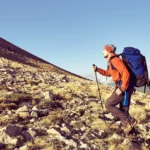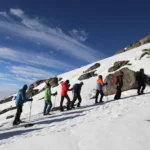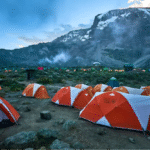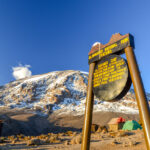Preventing and treating blisters is crucial for a comfortable and successful climb, especially when tackling a challenge like Kilimanjaro. At Kermali Tours & Safaris Ltd, your well-being is our priority, and we’ve put together a comprehensive guide to help you avoid and manage blisters during your climb.

Prevention Tips
- Choose the Right Footwear: Invest in well-fitting, broken-in hiking boots that provide proper support. Ensure there’s enough room for your toes to move without rubbing against the front of the boot.
- Wear Moisture-Wicking Socks: Opt for moisture-wicking socks to keep your feet dry. Wet conditions increase the likelihood of blisters, so change into dry socks if your feet become damp.
- Use Liner Socks: Consider wearing thin liner socks beneath your regular hiking socks. Liner socks reduce friction and can help prevent blisters from forming.
- Properly Adjust Boot Laces: Adjust your boot laces to avoid pressure points. Ensure your boots are snug but not too tight, especially around the ankles.
- Break in Your Footwear: Wear your hiking boots well before the climb to break them in. This allows your feet to adjust to the boots and reduces the risk of blisters.
- Keep Feet Clean and Dry: Maintain good foot hygiene. Clean your feet daily and dry them thoroughly, especially between your toes.

During the Climb
- Regularly Check Your Feet: Take breaks to check your feet for any signs of hotspots or irritation. Catching issues early can prevent them from developing into blisters.
- Address Hotspots Immediately: If you feel any discomfort or notice a hotspot (a reddened area), stop and address it immediately. Apply moleskin or blister prevention patches to reduce friction.
- Keep Your Feet Dry: If your feet get wet, dry them at the earliest opportunity. Consider bringing extra socks to change into during breaks if needed.
Treatment Tips
- Address Blisters Early: If a blister forms, it’s essential to address it as soon as possible. Clean the area with antiseptic wipes and sterilize a needle or pin with a flame.
- Drain the Blister: Carefully puncture the blister near its edge, allowing the fluid to drain. Leave the blister’s roof intact to protect the underlying skin.
- Apply Antiseptic Ointment: After draining the blister, apply antiseptic ointment and cover it with a sterile bandage or blister pad. This helps prevent infection.

- Use Moleskin or Blister Pads: Apply moleskin or blister pads to areas prone to friction. These protective barriers can help prevent new blisters from forming.
- Change Socks Regularly: Keep your feet clean and dry. Change into clean, dry socks regularly to reduce moisture and friction.
- Consider Taping Problem Areas: Use athletic or medical tape to protect areas prone to blisters. Taping can provide an additional layer of protection and reduce friction.

Kermali Tours & Safaris Ltd Support
- Professional Local Kilianjaro Guides: Our experienced local Kilimanjaro guides at Kermali Tours & Safaris Ltd are trained to assist with foot care during the climb. Feel free to communicate any discomfort, and they’ll provide guidance and support.
- First Aid Kit: We carry a comprehensive first aid kit, including items for blister care. Our Local Kilimanjaro guides are equipped to address minor medical issues, ensuring your well-being throughout the climb.
Conclusion:
By following these tips and with the support of Kermali Tours & Safaris Ltd, you can minimize the risk of blisters and manage them effectively if they do occur. Our commitment is to make your Kilimanjaro trek a safe, comfortable, and memorable experience.








